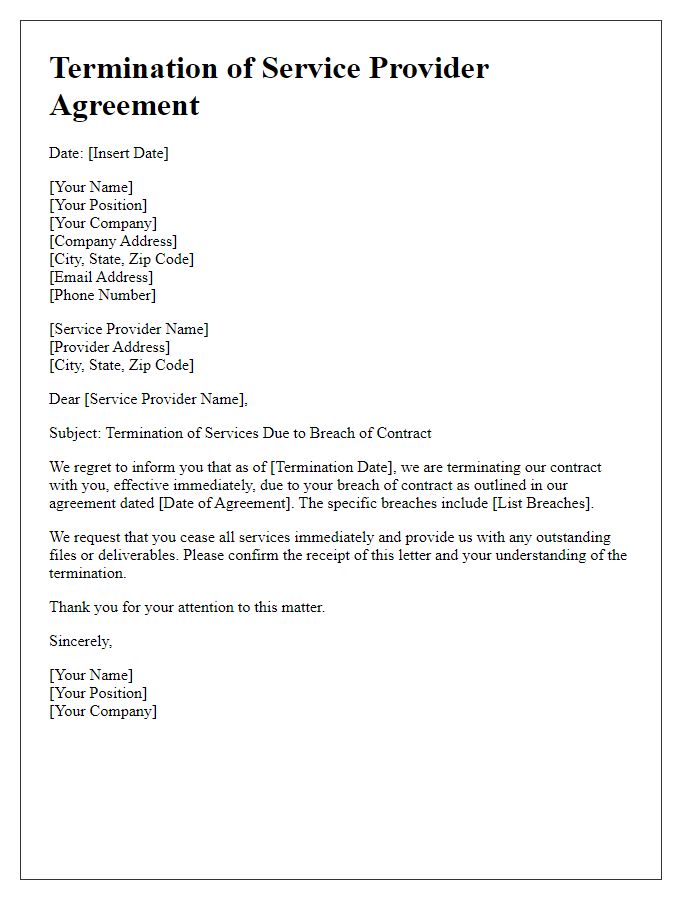Are you considering ending a service agreement but unsure how to communicate it effectively? Writing a termination letter can feel daunting, but it's essential to approach it with clarity and professionalism. In this article, we'll outline a straightforward template that covers all the necessary points, ensuring your message is both respectful and direct. Join us as we guide you through creating the perfect termination letter that suits your needs!

Clear Subject Line
A service provider termination involves officially ending a contractual agreement with a service provider, often due to unsatisfactory service or changes in business needs. Each termination letter should have a clear subject line, such as "Termination of Service Agreement" to immediately communicate the letter's purpose. This official correspondence must include specific details such as the service provider's name, address, and the effective date of termination, typically providing a notice period outlined in the original contract. Additionally, referencing the contract number enhances clarity regarding the agreement being terminated. Expressing a reason for termination, while remaining professional, can also aid in maintaining a neutral relationship for potential future interactions. Remember to ask for a confirmation of receipt to ensure proper communication.
Account Information
To terminate a service provider account, customers need to provide specific account information. This typically includes account number, name of the account holder, and associated email address used for registration. Additionally, identifying key service details such as the type of service (e.g., internet, mobile, cable) and any applicable billing information can facilitate a smooth termination process. Customers should also note any terms of service related to cancellation and potential final billing cycles or fees. For reference, this procedure should align with the service provider's official termination policy, which may vary by company and location.
Termination Effective Date
Termination of a service provider relationship can have significant implications for businesses, especially in areas such as telecommunications or software services. A clear termination effective date, typically specified in the termination notice, marks the conclusion of the contractual obligations between both parties, such as ABC Telecom and XYZ Corporation. Standard practices recommend providing at least 30 days' notice before the effective date, allowing for a smooth transition of services and potentially minimizing disruption to ongoing operations. This timeframe also enables the service provider to finalize outstanding invoices or equipment returns, ensuring compliance with the termination clauses outlined in the agreement. Clear communication regarding the effective date aids in setting expectations and avoiding misunderstandings during the transition period.
Reason for Termination
Termination of services often arises due to unsatisfactory performance levels, miscommunication, or breaches of contract. Notable factors include consistent delays in service delivery, lack of responsiveness in customer support, or failure to meet agreed-upon standards. In some cases, contractual obligations might not be fulfilled, leading to an erosion of trust. For example, if a service provider consistently fails to address issues within the stipulated 24-hour response window, the client may feel compelled to seek alternative solutions. Additionally, sudden price hikes or changes in service terms without prior notice can further contribute to the decision to terminate the partnership.
Contact Information for Follow-up
In the realm of business communications, precise contact information serves as a critical facilitator for ongoing relationships or resolution processes. Including direct phone numbers (e.g., +1-555-123-4567) and email addresses (such as contact@example.com) ensures seamless engagement with key personnel. Additionally, providing effective timelines (like a follow-up window of 24 to 48 hours) and specific business hours (e.g., Mondays to Fridays, 9 AM to 5 PM) can enhance clarity and accessibility. Reflecting a professional tone, the inclusion of names and titles, such as John Smith, Account Manager, or Sarah Johnson, Customer Support Lead, fosters trust and accountability.
Letter Template For Service Provider Termination Samples
Letter template of service provider termination for unsatisfactory performance

Letter template of service provider termination due to breach of contract

Letter template of service provider termination for cost-cutting measures

Letter template of service provider termination based on project completion

Letter template of service provider termination for a change in company direction

Letter template of service provider termination for inconsistent communication

Letter template of service provider termination related to business restructuring

Letter template of service provider termination for non-compliance with policies

Letter template of service provider termination due to lack of innovation





Comments